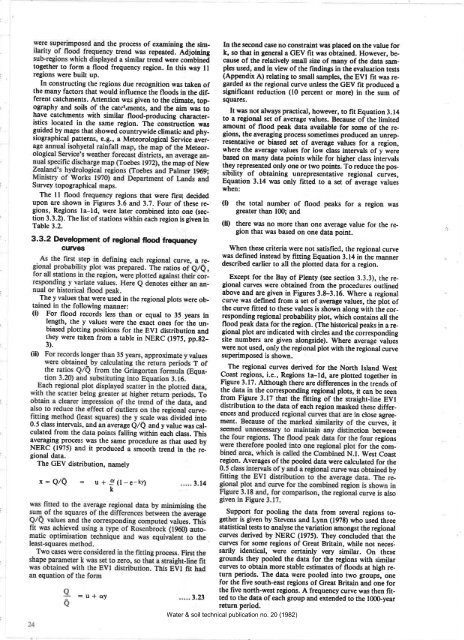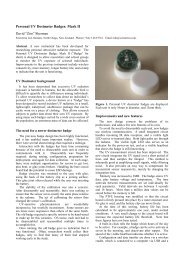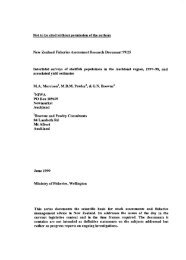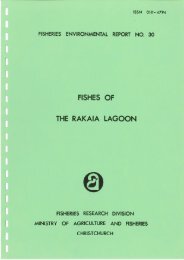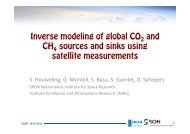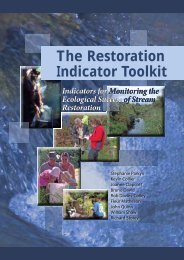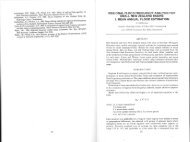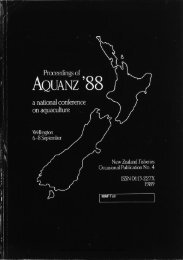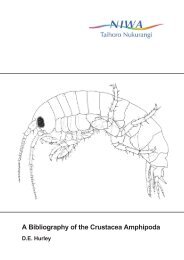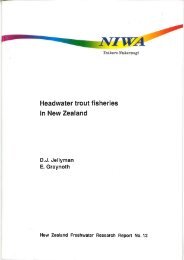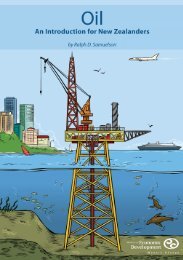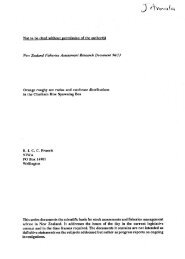WATER & SOIL - These are not the droids you are looking for.
WATER & SOIL - These are not the droids you are looking for.
WATER & SOIL - These are not the droids you are looking for.
Create successful ePaper yourself
Turn your PDF publications into a flip-book with our unique Google optimized e-Paper software.
e process of examining <strong>the</strong> simtrend<br />
was repeated. Adjoining<br />
d a similar trend were combined<br />
toge<strong>the</strong>r to <strong>for</strong>m a flood frequency region. In this way ll<br />
regions were built up.<br />
In constructing <strong>the</strong> regions due recognition was taken of<br />
<strong>the</strong> many factors that would influence <strong>the</strong> floods in <strong>the</strong> different<br />
catchments. Attention was given to <strong>the</strong> climat€, topography<br />
and soils of <strong>the</strong> catcr,ments, and <strong>the</strong> aim was to<br />
have catchments with similar flood-producing characteristics<br />
located in <strong>the</strong> same region. The construction was<br />
guided by maps that showed countrywide climatic and physiographical<br />
patterns, e.g., a Meteorological Service ãvei-<br />
Survey topographical maps.<br />
The ll flood frequency regions that were fîrst decided<br />
upon <strong>are</strong> shown in Figures 3.6 and 3.7. Four of <strong>the</strong>se regions,<br />
Regions la-ld, were later combined into one (section<br />
3.3.2). The list of stations within each region is given in<br />
Table 3.2.<br />
3.3.2 Development of reglonat flood frequency<br />
cutves<br />
The y values that were used in <strong>the</strong> regional plots were ob_<br />
tained in <strong>the</strong> following ma¡ner:<br />
(i) For flood records less than or equal to 35 years in<br />
length, <strong>the</strong> y values were <strong>the</strong> exact ones <strong>for</strong> <strong>the</strong> unbiased<br />
plotting positions <strong>for</strong> <strong>the</strong> EVI distribution and<br />
<strong>the</strong>y were taken from a table in NERC (1975, pp.g2_<br />
3).<br />
(¡i)<br />
0.5 class intervals, and an average e/Q and y value was calculated<br />
from <strong>the</strong> data points falling within each class. This<br />
averaging process was <strong>the</strong> same procedure as that used by<br />
NERC (1975) and it produced a smooth trend in <strong>the</strong> regional<br />
data.<br />
The GEV distribution, namely<br />
In <strong>the</strong> second case no constraint was placed on <strong>the</strong> value <strong>for</strong><br />
k, so that in general a GEV fit was obtained. However, because<br />
of <strong>the</strong> relatively small size of many of <strong>the</strong> data samples<br />
used, and in view of <strong>the</strong> findings in <strong>the</strong> evaluation tests<br />
(Appendix A) relating to small samples, <strong>the</strong> EVI fit was regarded<br />
as <strong>the</strong> regional curve unless <strong>the</strong> GEV fit produced a<br />
significant reduction (10 percent or more) in <strong>the</strong> sum of<br />
squ<strong>are</strong>s.<br />
It was <strong>not</strong> always practical, however, to fit Equation 3.14<br />
to a regional set of average values. Because of <strong>the</strong> limited<br />
amount of flood peak data available <strong>for</strong> some of <strong>the</strong> regions,<br />
<strong>the</strong> averaging process sometimes produced an unrepresentative<br />
or biased set of average values <strong>for</strong> a region,<br />
where <strong>the</strong> average values <strong>for</strong> low class intervals of y were<br />
based on many data points while <strong>for</strong> higher class intervals<br />
<strong>the</strong>y represented only one or two points. To reduce <strong>the</strong> possibility<br />
of obtaining unrepresentative regional curves,<br />
Equation 3.14 was only fitted to a s€t of average values<br />
when:<br />
(l) <strong>the</strong> total number of flood peaks <strong>for</strong> a region was<br />
greater than lü); and<br />
(ll) <strong>the</strong>re was no more than one average value <strong>for</strong> <strong>the</strong> region<br />
that was based on one data point.<br />
When <strong>the</strong>se criteria were <strong>not</strong> satisfied, <strong>the</strong> regional curve<br />
was defined instead by fitting Equation 3.14 in <strong>the</strong> manner<br />
described ea¡lier to all <strong>the</strong> plotted data <strong>for</strong> a region.<br />
Except <strong>for</strong> <strong>the</strong> Bay of Plenty (see section 3.3.3), <strong>the</strong> regional<br />
curves were obtained from <strong>the</strong> procedures outlined<br />
above and <strong>are</strong> given in Figures 3.8-3.16. tilhere a regional<br />
curve wÍrs dehned from a set of average values, <strong>the</strong> plot of<br />
<strong>the</strong> curve fitted to <strong>the</strong>se values is shown along with <strong>the</strong> corresponding<br />
regional probability plot, which contains all <strong>the</strong><br />
flood peak data <strong>for</strong> <strong>the</strong> region. (The historical peaks in a regional<br />
plot <strong>are</strong> indicated with circles and <strong>the</strong> corresponding<br />
site numbers <strong>are</strong> given alongside). Where average valuei<br />
were <strong>not</strong> used, only <strong>the</strong> regional plot with <strong>the</strong> regional curve<br />
superimposed is shown.<br />
The regional curves derived <strong>for</strong> <strong>the</strong> North Island West<br />
Coast regions, i.e., Regions la-ld, <strong>are</strong> plotted toge<strong>the</strong>r in<br />
Figure 3.17. Although <strong>the</strong>re <strong>are</strong> differences in <strong>the</strong> trends of<br />
<strong>the</strong> data in <strong>the</strong> corresponding regional plots, it can be seen<br />
from Figure 3.17 that <strong>the</strong> flrtting of <strong>the</strong> straight-line EVI<br />
distribution to <strong>the</strong> data of each region masked <strong>the</strong>se differences<br />
in close agree_<br />
ment.<br />
seeme<br />
<strong>the</strong> curveS, it<br />
ction between<br />
four regions<br />
<strong>for</strong> <strong>the</strong> com-<br />
. Vy'est Coast<br />
region. Averages of<strong>the</strong> pooled data were calculated <strong>for</strong> <strong>the</strong><br />
x=Q/Q<br />
= u*9(l-e-tv¡<br />
k<br />
3t4<br />
24<br />
a :a<br />
=U*oy 323<br />
Support <strong>for</strong> pooling <strong>the</strong> data from several regions toge<strong>the</strong>r<br />
is given by Stevens and Lynn (lg8) who used three<br />
statistical tests to analyse <strong>the</strong> variation amongst <strong>the</strong> regional<br />
curves derived by NERC (1975). They concluded that <strong>the</strong><br />
curves <strong>for</strong> some regiôns of Great Britain, while <strong>not</strong> necessarily<br />
identical, were certainly very similar. On <strong>the</strong>se<br />
grounds <strong>the</strong>y pooled <strong>the</strong> data <strong>for</strong> <strong>the</strong> regions with similar<br />
curves to obtain more stable estimates of floods at high return<br />
periods. The data were pooled into two groups, one<br />
<strong>for</strong> <strong>the</strong> fïve south-east regions of Great Britain and one <strong>for</strong><br />
<strong>the</strong> five north-west regions. A frequency curve was <strong>the</strong>n fitted<br />
to <strong>the</strong> data of each group and extended to <strong>the</strong> lüXÞyear<br />
return period.<br />
Water & soil technical publication no. 20 (1982)


